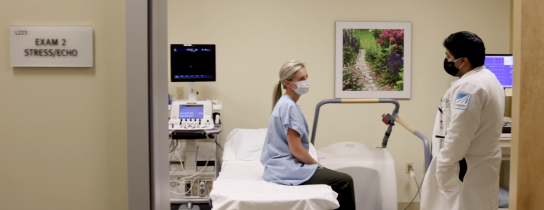Nuclear Stress Tests: FAQs

Nuclear Stress Tests: FAQs
Crystal Run’s nuclear cardiology labs were among the first in North America to be recognized by the Intersocietal Commission for the Accreditation of Nuclear Medicine Laboratories (ICANL) (now the Intersocietal Accreditation Commission or IAC) for our commitment to high-quality care and quality diagnostic testing.
Nuclear cardiology studies use noninvasive techniques to assess myocardial blood flow, evaluate the pumping function of the heart, and visualize the size and location of a heart attack.
If your physician has ordered a nuclear stress test, you may wonder how to prepare for it and what to expect. Below, we have listed some of our most frequently asked questions. If you require further information, please contact our office at 845-703-6999.
Frequently Asked Questions About Nuclear Stress Tests
1. How should I prepare for the procedure?
You should avoid drinking caffeine/decaf (coffee, tea, etc.) and smoking for 12 hours before the examination. You should not eat or drink anything four hours prior to the procedure. Wear comfortable, rubber-soled walking shoes and loose-fitting clothes for your procedure.
2. What does the equipment look like?
The imaging equipment, called a gamma camera, consists of specialized detectors enclosed within a metal housing ring. This IS NOT an MRI scanner. The gamma camera will move slowly and automatically in an arc over the front of your chest after the technologist positions it. Please inform the nurse or technologist if you are claustrophobic (cannot withstand enclosed spaces) or cannot lie flat on your back for a period of time.
3. How is the procedure performed?
For the stress part of the examination, you will exercise by either walking on a treadmill or having a medication test.
- While you exercise, an EKG will monitor the electrical activity of your heart, and your blood pressure will be measured frequently. Before you stop exercising, you will be given a radioactive tracer through an IV line in the arm. The compound is given when the blood flow to the heart is at its peak rate, caused by your exercise. This provides the best opportunity to identify regions of the heart that are not receiving adequate blood flow.
- One minute later, you will stop exercising. Approximately 15-30 minutes later, you will lie on the gamma camera table for imaging.
- If you are unable to use a treadmill, you will instead be given medication that will cause your heart vessels to dilate. You will next be given the radioactive tracer. Approximately 90 minutes after that, you will lie on the gamma camera table for imaging.
4. What will I experience during and after the procedure?
- You will be asked to exercise until you are either too tired to continue or short of breath, or if you experience chest pain, leg pain, or other discomfort that causes you to want to stop.
- You may experience a cool sensation from the intravenous injection of the radioactive tracer because the saline fluid is at a lower temperature than your body. You might experience some discomfort while on the camera, since one or both arms will be above your head.
- If you are given medication test, you may experience a brief period of anxiousness, dizziness, nausea, or shortness of breath. If the side effects of the medication persist or become uncomfortable, another medication can be given to stop the effects.
- You may resume regular activities after the procedure (eating, driving, etc.). The radioactivity in your body will decrease over a short period of time, passing out of your body through your urine and stool or natural decay.
5. Are there any side effects to the radioactive tracer?
Some patients experience a slight taste in their mouth or a smell. The solution is a saline-based material; therefore, you will not feel any different. Please note, however, that you will be radioactive for 12 hours.
6. Does this material change the color of your urine?
No. if you experience color-change with your urine, please see a physician. This will not be related to the test.
7. Should I take my medications?
For the resting portion of the test, you may take all prescribed medications. For the stress portion of the test, please see instructions or speak with your physician.
8. What does the test show?
This test will show if you have any blocked arteries or have ever had a heart attack. Please be aware that both parts of the test are needed for an adequate reading of the test unless otherwise specified by the reading or your cardiologist.

 Optum Radiology at Crystal Run Healthcare
Optum Radiology at Crystal Run Healthcare Request medical records online
Request medical records online